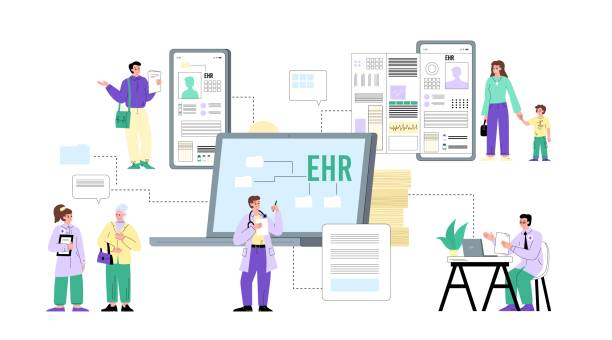Transitioning to an Electronic Health Record (EHR) system can transform your therapy practice, offering benefits like streamlined documentation, improved client engagement, and enhanced compliance. However, the implementation process can be challenging without a clear plan, potentially leading to disruptions in your workflow or resistance from your team. How to successfully implement an EHR in your therapy practice is about following a structured approach to ensure a smooth transition, maximizing the benefits of your new system while minimizing stress. In this guide from Mental Health IT Solutions (MHIS), I’ll walk you through the key steps to implement an EHR effectively, helping you modernize your practice with confidence.
Understanding the Importance of a Successful EHR Implementation
Implementing an EHR is a significant change for any therapy practice, requiring careful planning to ensure it meets your needs and integrates seamlessly into your workflow.
Why EHR Implementation Matters for Therapists
Benefits of Going Digital
An EHR can save time on documentation, improve access to client records, and support teletherapy, allowing you to focus more on client care. It also ensures compliance with regulations like HIPAA, protecting your practice from legal risks. For more on the benefits of digital systems, check out Paperless Therapy: Transitioning from Manual Records to a Digital EHR System.
Risks of Poor Implementation
Without a proper plan, EHR implementation can lead to issues like data migration errors, staff resistance, or workflow disruptions, which can frustrate your team and impact client care. A successful implementation avoids these pitfalls, setting your practice up for long-term success.
The Role of Planning in Implementation
Setting the Stage for Success
A well-planned implementation ensures that your EHR aligns with your practice’s goals, whether you’re a solo therapist or part of a group practice. It also minimizes disruptions, making the transition smoother for you, your team, and your clients.
Building Confidence in the System
A successful implementation builds confidence in the EHR, encouraging adoption by your team and ensuring you can leverage its full potential to enhance your practice, a key aspect of how to successfully implement an EHR in your therapy practice.
Steps to Successfully Implement an EHR in Your Therapy Practice
Let’s explore the key steps to implement an EHR, focusing on practical actions to ensure a smooth and effective transition.
1. Assess Your Practice’s Needs and Goals
Identify Your Requirements
Start by evaluating your practice’s specific needs. Are you a solo therapist looking for simplicity, or a group practice needing multi-user support? Do you offer teletherapy, or do you need robust billing features? Understanding your needs will guide your choice of EHR. For more on assessing your needs, see EHR vs. Practice Management Software: Which One Do Therapists Need?.
Set Clear Objectives
Define what you want to achieve with your EHR, such as reducing documentation time, improving client engagement, or ensuring HIPAA compliance. Clear goals will help you select the right system and measure the success of your implementation.
2. Choose the Right EHR for Your Practice
Prioritize Mental Health-Specific Features
Select an EHR designed for mental health, with features like customizable templates for therapy notes, secure teletherapy, and client portals. Systems like SimplePractice, TherapyNotes, and TheraNest are tailored to the needs of therapists, offering tools to support narrative-based documentation and privacy requirements. For more guidance, refer to Choosing the Best EHR for Your Therapy Practice: A Complete Guide.
Test the System
Sign up for a free trial or demo to evaluate the EHR’s usability, features, and fit with your workflow. Test key functions like documentation, scheduling, and billing to ensure they meet your needs. For a list of essential features, check out Top Features to Look for in a Mental Health EHR System.
3. Plan Your Implementation Process
Create a Timeline
Develop a realistic timeline for implementation, including milestones like data migration, staff training, and going live. For example, you might allocate 2 weeks for data migration, 1 week for training, and a 1-month pilot phase before fully transitioning.
Assign Roles and Responsibilities
Designate a project lead to oversee the implementation, ensuring clear communication and accountability. In a group practice, involve your team in the process, assigning roles like data migration coordinator or training facilitator to distribute the workload.
4. Migrate Your Data to the EHR
Organize Existing Records
Before migrating, organize your current records—whether paper or digital—by client, ensuring all files are complete and up-to-date. This might involve sorting through paper files, removing duplicates, and flagging any missing information.
Work with Your EHR Vendor
Most EHR providers offer data migration support, helping you transfer records into the system. For example, TheraPlatform can assist with scanning paper records or importing data from another EHR, ensuring a smooth transition. Schedule the migration during a low-activity period to minimize disruptions.
5. Train Your Team on the EHR System
Leverage Vendor Training Resources
Take advantage of the training resources provided by your EHR vendor, such as video tutorials, live webinars, or one-on-one support. For example, SimplePractice offers onboarding sessions to help you learn the system’s features, from documentation to teletherapy.
Conduct Internal Training
Train your team on how to use the EHR securely and efficiently, focusing on key tasks like documenting sessions, scheduling appointments, and accessing client portals. Role-play scenarios to address common challenges, ensuring everyone is comfortable with the system.
6. Ensure Security and Compliance
Verify HIPAA Compliance
Confirm that your EHR is HIPAA-compliant, with features like encryption, secure access controls, and audit trails. The vendor should also sign a Business Associate Agreement (BAA) to share responsibility for protecting client data. For more on compliance, see HIPAA Compliance and EHR: What Every Mental Health Professional Should Know.
Implement Security Protocols
Set up strong passwords, enable multi-factor authentication (MFA), and train your team on best practices, such as not sharing login credentials or accessing records on public Wi-Fi. These measures ensure your client data remains secure during and after implementation. For more on securing data, refer to How to Secure Patient Data with an EHR for Mental Health Practices.
7. Test and Go Live with the EHR
Start with a Pilot Phase
Begin by using the EHR for a small group of clients to test its functionality. Document a few sessions, schedule appointments, and submit test claims to identify any issues before fully transitioning. This pilot phase helps you address problems without impacting your entire caseload.
Transition Fully to the EHR
Once you’re confident in the system, transition all clients to the EHR. Communicate the change to your clients, explaining how it will improve their experience, such as through secure messaging or easier appointment scheduling. Shred or securely store any remaining paper records, following HIPAA guidelines for retention.
Benefits of a Successful EHR Implementation
Streamlined Documentation
A well-implemented EHR reduces documentation time with features like customizable templates and voice dictation, allowing you to focus on client care. For more on this, see How EHR Solutions Can Streamline Clinical Documentation for Therapists.
Enhanced Client Engagement
Features like secure client portals and teletherapy integration keep clients engaged, improving adherence to treatment plans and fostering better outcomes. For more on client care, check out The Role of EHR in Enhancing Patient Care and Therapy Outcomes.
Improved Compliance and Security
A successful implementation ensures your EHR meets HIPAA requirements, protecting client data and reducing legal risks. For more on cloud-based security, refer to How Cloud-Based EHR Systems Benefit Mental Health Clinics.
Increased Efficiency
By automating tasks like scheduling and billing, an EHR saves time and reduces administrative stress, allowing your practice to run more smoothly. For more on efficiency, see How EHR Software Improves Efficiency in Mental Health Practices.
Challenges to Consider During Implementation
Resistance to Change
Your team may resist adopting a new system, especially if they’re used to paper records. Involve them in the process, highlight the benefits, and provide thorough training to ease the transition.
Data Migration Issues
Migrating data can be complex, with risks of errors or missing information. Work closely with your vendor and double-check migrated data to ensure accuracy.
Initial Time Investment
Implementation requires time for planning, training, and testing, which can feel overwhelming. Break the process into manageable steps and set realistic expectations to avoid burnout.
How to Ensure Long-Term Success with Your EHR
Monitor and Optimize
After going live, monitor the system’s performance and gather feedback from your team. If issues arise, such as difficulty with documentation, work with the vendor to resolve them and optimize the system.
Customize Your EHR
Tailor your EHR to fit your specific documentation needs, such as creating custom templates or configuring privacy settings. For more on this, see EHR Customization: Tailoring Your System for Mental Health Documentation.
Stay Updated on Trends
Keep an eye on emerging EHR trends, such as AI integration or advanced telehealth features, to ensure your system remains relevant. For more on this, refer to The Future of EHR in Behavioral Health: Trends to Watch.
The Long-Term Impact on Your Practice
Mastering how to successfully implement an EHR in your therapy practice can set your practice up for long-term success. By streamlining operations, enhancing client care, and ensuring compliance, an EHR helps you focus on what matters most—helping your clients thrive. Over time, this leads to higher client satisfaction, reduced stress, and a more sustainable practice, making the implementation process a worthwhile investment.
Final Thoughts
How to successfully implement an EHR in your therapy practice offers a clear path to modernizing your practice. By following these steps, you can ensure a smooth transition, maximizing the benefits of your EHR while minimizing disruptions. Partnering with Mental Health IT Solutions can help you navigate this process. Ready to explore why a specialized EHR is essential?
Visit Why Mental Health Therapists Need a Specialized EHR System for more insights.







